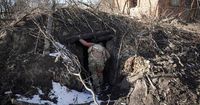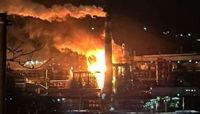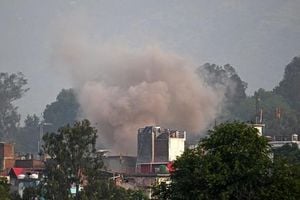On March 21, 2025, the conflict between Ukraine and Russia took a dramatic turn as Ukraine launched a series of bold strikes against key energy infrastructure in the Kursk region. Reports indicate that this assault targeted the Sudzha gas pumping station, a critical route for gas shipments from Russia to Europe. This action not only signifies a direct escalation in the ongoing military engagement but also poses significant implications for energy security across the continent.
The Sudzha station was reportedly hit in the early hours of March 21, triggering a fire that would draw significant attention both locally and internationally. Ukrainian forces seem to have executed the attack with increasing confidence, utilizing advanced tactical strategies. Dmitry Peskov, the Kremlin spokesperson, condemned the strike, emphasizing that such actions demonstrate Ukraine's unwillingness to pursue peace negotiations. Peskov stated, "The idea that Russia would destroy its own energy infrastructure is 'absurd.'" This assertion reflects the Kremlin’s stance on the events unfolding, as it seeks to divert blame back onto Ukraine.
In the aftermath of the Sudzha incident, Russian military operations are purportedly underway, labeled "Stream", which has been in preparation for three months. According to Commander Morpekh of the Russian Airborne Forces, there were strategic movements involving approximately 500 Russian servicemen, who stepped into positions along dual exits of the pipeline system. Morpekh explained, "We cannot let many soldiers leave the pipeline through just one way... we will suffer heavily." This preparatory phase appears to signify Russia's determination to regain control and bolster its military presence in the region.
Meanwhile, the situation escalated further with a reported significant explosion at an oil depot in Kursk. The attack was attributed to Ukrainian drone strikes, although Russian officials claimed that the fire had spread following their own failed operations. Reports indicated that two personnel were injured in the blaze as firefighters worked to contain it amidst chaotic conditions. The deputy governor of the region noted that repairs to the damaged Tuapse refinery, another site that reportedly came under drone attack just hours earlier, are projected to cost around 12 billion rubles, potentially affecting Russian oil exports considerably.
Adding to the military sophistication displayed in these operations, Ukraine has seemingly deployed newer weaponry, such as upgraded Neptune missiles. Initially, it was suggested that these missiles had a range of 150 kilometers; however, subsequent analyses by defense experts raised speculation regarding their capabilities, hinting at an effective range extended to 1,000 kilometers. This advancement could radically transform the dynamics of military confrontations, allowing Ukraine to strike deeper into Russian-held territories.
As the conflict unfolds, both sides attribute blame for the violence and disruption of crucial infrastructure—each accusing the other of belligerence and aggression. On the same day as the attacks, the Ukrainian military dismissed claims that they had detonated the oil facility, asserting that Russia was to blame. This cycle of escalation is accompanied by redoubles efforts from both Ukrainian and Russian military commands, highlighting the urgency and desperation felt on either end.
The geopolitical ramifications of the current conflict stretch far beyond the immediate battlegrounds. Europe, which heavily relies on Russian energy supplies, braces itself for the ramifications of targeted strikes against its energy infrastructure. Analysts warn that continued disruption in the supply lines could lead to rising energy prices, heightened tension within the European Union, and catalyze a broader shift in how Western nations approach their energy needs.
This latest sequence of events underscores the fragility of stability within the region and raises questions about future engagements between Russian and Ukrainian forces. Observers are keen to monitor how the ongoing military strategies will play out in the coming days and whether peace talks may emerge from these turbulent exchanges.
With military assets now positioned and various factions mobilized for potential escalations, the immediate future remains uncertain. Will combatants find common ground amid these hostilities, or will each new attack further entrench positions on the ground? As countries worldwide watch the developments unfold, the reality of the situation becomes painfully clear: the struggle for dominance in Eastern Europe continues, with uncertainty looming like a thick fog over both nations.





